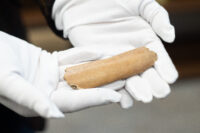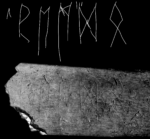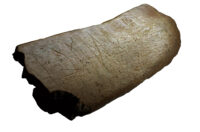 A bovine rib bone inscribed in Elder Futhark runes is the oldest writing system ever used by ancient Slavs. It is also the first archaeological evidence of direct contact between the Germanic tribes of Central Europe and the Early Slavs.
A bovine rib bone inscribed in Elder Futhark runes is the oldest writing system ever used by ancient Slavs. It is also the first archaeological evidence of direct contact between the Germanic tribes of Central Europe and the Early Slavs.
The bone was discovered in Břeclav-Lány, South Moravia, Czech Republic, in a 2017 excavation of an Early Slavic settlement occuped from the 6th-7th century to the 9th. It was in a pit with other animal bones, handmade pottery and clay pans. Radiocarbon analysis of the inner section of the bone dates it to between 585-640 A.D. The date range makes this pit the earliest absolute dated Early Slavic feature in the Czech Republic and Austria.
 The inscription consists of six of the last eight runes of Elder Futhark. The vast majority of the 430 extant examples of Elder Futhark are personal names. Only 17 of them are abecedaries, whole or partial, and this is the only one with the final part of the runic alphabet; the others are missing the last three runes. It is also the first one found in a non-Germanic archaeological context.
The inscription consists of six of the last eight runes of Elder Futhark. The vast majority of the 430 extant examples of Elder Futhark are personal names. Only 17 of them are abecedaries, whole or partial, and this is the only one with the final part of the runic alphabet; the others are missing the last three runes. It is also the first one found in a non-Germanic archaeological context.
Archaeologists believe that bone originally contained the entire alphabet but only the broken end of it has survived. Because it’s an abecedary rather than a word, it’s likely the bone was used as a teaching tool. The carver appears to have been inexperienced. In addition to the missing runes l and ŋ, there are errors of proportion and extra lines from repeated attempts at a rune.
 Before this discovery, the earliest script encountered by the Slavic people was believed to be Glagolitic, an alphabet invented in the 9th century A.D. by Saints Cyril and Methodius of Byzantium to translate the Gospels into Slavic languages. The rune bone indicates that Slavs encountered a form of writing almost 300 years earlier than previously believed.
Before this discovery, the earliest script encountered by the Slavic people was believed to be Glagolitic, an alphabet invented in the 9th century A.D. by Saints Cyril and Methodius of Byzantium to translate the Gospels into Slavic languages. The rune bone indicates that Slavs encountered a form of writing almost 300 years earlier than previously believed.
This ground-breaking discovery made by archaeologists from Masaryk University demonstrates that before the introduction of the Glagolitic script the Slavs had come into contact with runes, which they may have used for counting or divination, for example. This finding also calls into question whether cultural differences between Germanic and Slavic Europe were so clear cut. “The fact that it is the earliest evidence of writing among Slavs is certainly interesting for the nearly 300 million people who speak Slavic languages,” added Macháček.
The study has been published in the Journal of Archaeological Science and can be read here.
What I don’t get is what is supposedly so particularly “Slavic” about this ‘bookstave’ (or -rib, in this case). The Greeks “Cyril(l)” and “Method” seem to have trumped up a Glogolitic alphabet from mainly Georgian and Armenian script.
Julius Caesar, on the other hand, labelled –unlike the folks on “his” side of the Rhine– the ones on the other side as “Germanic”, while the Greek Herodotus 400 years earlier had labelled the ones at the upper Danube, i.e. the mentioned other side of the Rhine, as “Keltoi”.
Caesar also reports that “his” Gauls were using Greek letters, and when a little later “Arminius” sent the severed head of Publius Quinctilius Varus to “Maroboduus”, the first documented ruler of Bohemia, he most likely added a few lines (presumably in Latin or Greek. When “Maroboduus” forwarded the head to Augustus, however, most likely in Latin).
To conclude, if we then have a look at the ease, at which the step from Glogolitic to “Cyrillic” script was taken at the lower Danube and elsewhere, it is maybe only fair to assume that an even earlier form of writing that those Slavs had encountered was most likely nothing but Greek.
:yes:
Cyril and Methodi are Bulgarians. Who created the alphabet based on Bulgarian emperor request …
Cyril and Methodius are Bulgarians. Who created the alphabet based on Bulgarian emperor request …
Their dad Leontios was most likely Greek and their mother might have been Bulgarian.
There is a controversy as to whether Cyril and Method were of Slavic or Byzantine Greek origin, or both: Actually, “both” seems reasonable.
Thessaloniki was named after Thessalonike of Macedonia, the daughter of Phillip II –who obviously was victorious in Thessalia– and half sister of Alex the Great.
What maybe could be said with certainty is that Makedons are probably not Bulgarians 😉
——–
PS: What the Bulgarian emperor may have requested from them, could have been: “Whatever you do, don’t make it look Greek!”
We started interesting discussion Corbinian :hattip:
Let’s ask an important question.
If they were only paid Greek scholars – what motivation did they have not only to create but spread the alphabet? To essentially dedicate their lives for it? And in so doing oppose both official religions at that time about the right to read the Bible in the Bulgarian language, just so it can be understood by the masses.
In addition to your post there are few things to consider:
1. Their granddad on their father side fled Bulgaria based on his religious beliefs. There are many historically documented strong suggestions that he was Arian orthodox.
2. At that point in time there was no “Greece” or Macedon but Provence’s named since Roman occupation. They were part of the so called Byzantine Empire.
3. Again at that time the inhabitants of the Tessalokie (Halkidiki) peninsula were Bulgarians.
😉 😉 😉 Looking at the Glagolitic alphabet – created by the brothers I don’t see much similarities with Greek. But with current Cyrillic letters -yes there are a lot. So for me the question is -which one was the first. :facepalm: